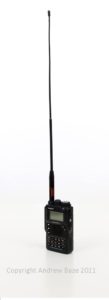The Yaesu VX-8R packs a lot of features into a tiny package. How tiny? Take a look! It’s about the size of a deck of cards, if you unscrew the antenna. Take a look at this:

What can you do with this radio? You can talk on four different amateur radio bands (50/144/222/430 MHz, if you’re interested), while listening to broadcast radio (for example, FM radio) at the same time!
You can use a Bluetooth headset with it, and you can attach a GPS receiver to the radio or to a an attached speaker microphone. When you have GPS installed, you can also use APRS functionality, which means you can transmit your location to other radios, can send and receive simple text messages, and more.
If you wanted to get creative, you could even attach an special antenna and talk to an amateur radio satellite! It can receive weather alerts on special weather radio channels, can easily communicate with repeaters, and more. This is an amazing radio.
The VX-8R has been replaced by the VX-DR and the VX-GR. They’re all small, powerful, and loaded with features. Take a good look at the specifications, since there are some differences.
You can get more information at www.Yaesu.com, on the VX-8R, the VX-DR, and the VX-GR.
Of course, the antenna adds some size to the radio, but you have many options, from very small (usually inefficient, for short-range communications) to longer (more efficient, if you can conveniently carry it). For example, in the picture directly above you can see the VX-8R with a Diamond whip antenna, which is quite efficient. Soon, I’ll post a picture of my “stealth” antenna. It’s very small, and very inefficient, but very convenient when I need to carry my radio in an inside jacket pocket and only need to communicate short-range.
Is the VX-8R the only small radio? Is it the only one that does APRS? Are some easier to use? No, yes, and yes! Some other common, powerful, feature-filled radios are Icom’s IC-91A and Kenwood’s TH-F6A. And there are many more. Do your research and you’ll find a radio that fits you well. 73!

